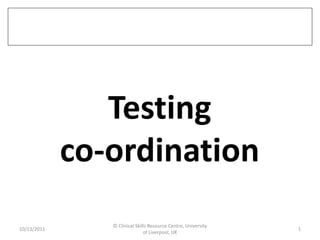More Related Content Similar to Coordination Exam Similar to Coordination Exam (20) More from meducationdotnet More from meducationdotnet (20) 2. Normal co-ordination
• Requires intact sensory, motor and vestibular
systems
• This includes sensory information carried in the
pathways already discussed AND normal vision
• The motor element of co-ordination requires
normal cerebellar function and connections
3. A person with normal co-ordination
can:
• Accurately approach/touch a target with tip
of finger with eyes open and closed
• Accurately slide heel down the opposite shin
• Maintain standing balance with eyes closed
• Walk in a straight line
4. 10/13/2011
© Clinical Skills Resource Centre, University
of Liverpool, UK
4
Definitions
• Ataxia
– lack of co-ordination
• Proprioception
– Proprioceptors in your muscles, tendons and
joints enable you to judge your body position and
enable you to co-ordinate movement
– Loss of proprioception can be accommodated for
by looking at your movement. However when the
eyes are closed, controlled movement becomes
very difficult
5. 10/13/2011
© Clinical Skills Resource Centre, University
of Liverpool, UK
5
Finger-nose co-ordination
• Ask patient to repeatedly touch their
nose and then the examiner’s finger
(held at the patient’s arm’s length)
• Test done slow and fast
• Repeat with eyes open and closed
Look for
• intention tremor
– increasing tremor as approaches target
• past pointing
– overshoots target
both occur with cerebellar disease
6. 10/13/2011
© Clinical Skills Resource Centre, University
of Liverpool, UK
6
Heel-shin co-ordination
• Patient runs heel down
front of the leg as quickly
and accurately as possible
to end with heel on big toe
• Repeat with eyes closed
• Cerebellar disease
– foot wanders side to side and
overshoots; eye closure
makes little difference
• Proprioceptive problems
– worsens with eyes closed
7. 10/13/2011
© Clinical Skills Resource Centre, University
of Liverpool, UK
7
Dysdiadochokinesis
• The patient is asked to
place one hand on top of
the other
• Then is asked to
repeatedly and quickly
pronate and supinate one
hand
• In cerebellar disease the
motion is slow and
clumsy
8. Patterns of Ataxia
Cerebellar
• Intention tremor
– +/- past pointing
• Dysdiadochokinesis
• Heel-shin ataxia
• Gait ataxia
• Often associated with
– nystagmus
– dysarthria
Sensory
• Ataxia evident on eye
closure
• Rombergism
• Impaired joint position
– +/- other sensory loss on
bedside testing
• Gait ataxia
9. 10/13/2011
© Clinical Skills Resource Centre, University
of Liverpool, UK
9
Testing gait
http://library.med.utah.edu/neurologicexam/html/gait_abnormal.html#01
10. 10/13/2011
© Clinical Skills Resource Centre, University
of Liverpool, UK
10
Gait
• Ask the patient to walk
normally for a few metres,
turn quickly and return
• Observe for
– Stride length
– Pattern of leg movements
– Posture
– Arm swing
– Balance
– Symmetry
Both legs
should be
clearly
exposed
11. 10/13/2011
© Clinical Skills Resource Centre, University
of Liverpool, UK
11
Heel-toe gait
• Ask the patient to walk a
few steps, putting heel of
one foot directly ahead of
the contralateral toes -
“As if walking on a
tightrope”
12. 10/13/2011
© Clinical Skills Resource Centre, University
of Liverpool, UK
12
Some examples
• Hemplegic
– leg rigid and swings in a semi-circular motion
• Paraplegic
– typical “scissor” gait
• Parkinsonian
– small stepped, shuffling - loss of arm swing
• Cerebellar
– wide based, staggering towards side of the lesion
• Sensory ataxia
– stepping, stamping gait - needs to watch the floor
Remember possible musculoskeletal disorders
